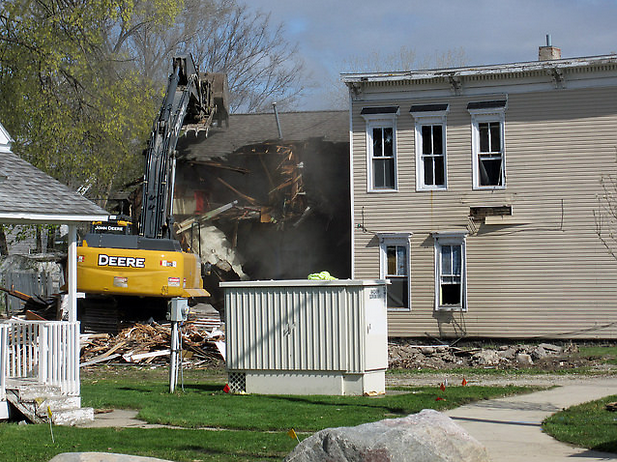It is a sign of a thriving city to see regular reinvestment and renewal in residential and business districts. New construction and rehabilitation of existing buildings and neighborhoods can be effective in meeting changing demands of both residents and businesses. Such new investment can make a city an attractive place to work, live and visit. It can also strengthen the tax base, allowing government to be more effective in addressing the needs of all residents.
Reinvestment, however, does not occur in a random pattern. It is typically concentrated in neighborhoods where private investment dollars are most likely to realize maximum return. It is encouraged by government policies and actions like Tax Increment Financing (TIF) Districts, Neighborhood Enterprise Zones (NEZ), improvements to city streets and other public amenities, acceptance of tax breaks to attract large business that might anchor neighborhood economies and stricter enforcement of city building/housing codes. Private developers, home buyers and commercial property buyers play a large role in reinvestment with their decisions to purchase and/or rehab property in a given city neighborhood.
Both government and private sector actions can help to define “hot” neighborhoods. Real estate agents define certain neighborhoods as having a “good return on investment,” or as a place where first-time home-buyers can get a “good house for their money.”
Gentrification is a sign of economic growth. As money begins to flow into a neighborhood, many aspects of everyday life are changed for the better. Buildings and parks are renovated and beautified. Jobs arrive with the increased construction activity and new retail and service businesses. Crime rates decline. As the property tax base increases, so does funding to local public schools. Formerly racially homogeneous neighborhoods get an influx of diversity.
There are some things to applaud about the power of gentrification. These are the good results of reinvestment.
But here are some things to consider:
- Are the benefits of economic growth shared equitably by new and old residents alike?
- What is the social cost of economic growth?
These two questions raise a host of others, such as:
- Do wealthier new arrivals reap the majority of the benefits of increased economic activity?
- How does the arrival of new “tastes,” expectations and demographics damage the social and cultural fabric of a neighborhood?
We need to closely consider both the benefits and problems with reinvestment- and who is on the receiving end of each of those- more closely.
The reinvestment process is often intertwined with displacement of existing residents and businesses. Existing low-income and working class residents are forced out by increased rents, condominium conversions and increased home ownership costs like property tax increases.
The general pattern of displacement does not begin when reinvestment has already happened. Displacement is, in fact, the start of the cycle of reinvestment with- ironically enough- disinvestment. Minimal repairs are made to residential property and retail stores disappear. Both homes and businesses become empty. Increased absentee ownership results in deterioration and eventual destruction of housing and businesses. Vacant lots can be a visible indicator of future displacement; they are effectively the placeholders for future development.
Displacement makes way for demolition for new construction or rehabbing of homes. Then this property improvement increases property value for the specific homes, which increases property taxes in the entire area. Higher rents in the improved buildings, and others struggling with rising property taxes, results in displacement of low income and fixed income renters as well as homeowners who cannot afford the higher taxes.
The standard picture of gentrification is that the new arrivals benefit greatly from gentrification at the expense of long-standing residents. The new arrivals get modern, stylish housing and all of the expensive furnishings of life in a trendy urban neighborhood (boutiques, bookstores, coffee shops, clubs and more).
While long-time residents may benefit initially from cleaner, safer streets and better schools, they are eventually priced out of renting or buying. As the new arrivals impose their culture on the neighborhood, lower-income residents become economically and socially marginalized. This can lead to resentment and community conflict that feeds racial and class tensions. It creates a tense social dynamic with “them versus us” conflicts between the gentrifiers and the displaced residents.
We have seen housing and business disinvestment take place over several decades on our Southeast and West Sides for our low income residents. The displacement of residents and the process of reinvestment are spread out during a longer period of time.
Gentrification does not happen when the fancy new restaurants arrive. Gentrification is measured in decades rather than single years.
But reinvestment does not have to follow these standard cycles we've become used to seeing.
LINC Community Revitalization practices zero displacement of residents when redeveloping neglected and blighted properties. LINC’s practice of zero displacement must become the standard we hold for those looking to redevelop commercial and residential property in historically African American, Latino and working class neighborhoods in Grand Rapids.
Ask yourself why are there pockets of generational poverty, visual areas of disinvestments, high crime rates, low performing schools and high unemployment rates in predominately African American and Latino neighborhoods in Grand Rapids, Michigan.
When we're honest, we already know the answer to this question: systemic and institutional racism.
Institutional racism is defined as any system of inequality based solely on race. It can occur in public government bodies, private business corporations and in public and private education.
One practice that helped to create the cycle of exclusion was the broadly enforced system of redlining. Redlining is the practice of denying, or charging more for, services such as banking, home loans, insurance, access to health care, and even supermarkets. Redlining includes denying local jobs to residents in particular, often based on race.
During the heyday of redlining, the areas most frequently discriminated against were African American inner city neighborhoods. These communities were often accused of not valuing their homes and community. But without equitable and equal access to capital and services, how can anyone accuse them of not valuing what they were denied the equal opportunity to develop?
Redlining, though now illegal, still pervades our systems and institutions today.
Long time residents of neighborhoods undergoing reinvestment were legally and are now illegally excluded from economic opportunities. At the same time, they are somehow expected not to resist or resent the gentrifiers that are aided by state and locally elected officials and policies.
Some would have you believe that the economic gains or benefits of gentrification is positive for all residents.
But we in the African American community know that those rising tides have never raised our boat. Our boat has far too many leaks to be raised. Our boat just remains at the bottom with a few pieces of our boat- a few individuals from our community- are able to slowly make their way to the top. Grand Rapids will never be a sustainable world class city if it intentionally leaves a significant portion of its population behind.
You don’t have to look far for examples of how predominately African American and Latino neighborhoods will be impacted by gentrification. We can use Wealthy Street and Cherry Street as case studies.
Those of you who have been living in Grand Rapids from the early 90s to now can see how the area has changed and those that have benefited versus those who have not benefited from gentrification. How will other areas being targeted for “reinvestment” and “renewal” results be any different?
It won’t be any different. Nothing will change unless long time residents begin to increase their percentage of ownership in their neighborhoods and require of their elected representatives and those seeking office that more be done to facilitate reinvestment in African American and Latino neighborhoods (where tax dollars have always been collected but not returned equitably) in ways that no longer displace and change the racial and cultural identity of those residing within them.
It will ony change when residents no longer support agendas or candidates that don’t have their neighborhood interests as a priority, and instead become invested in those that do.
The impact of gentrification in any community is multifaceted. This is why private dollars looking at redeveloping and revitalizing a "neglected" neighborhood isn’t as simple as you might think.
Economic and social factors must be taken into consideration whenever people are considering widespread private investments in a geographic area affecting a large portion of a particular group of people.The cost of gentrification has been and will continue to be a price communities of Color cannot afford and must not accept.
The Rapidian, a program of the 501(c)3 nonprofit Community Media Center, relies on the community’s support to help cover the cost of training reporters and publishing content.
We need your help.
If each of our readers and content creators who values this community platform help support its creation and maintenance, The Rapidian can continue to educate and facilitate a conversation around issues for years to come.
Please support The Rapidian and make a contribution today.

